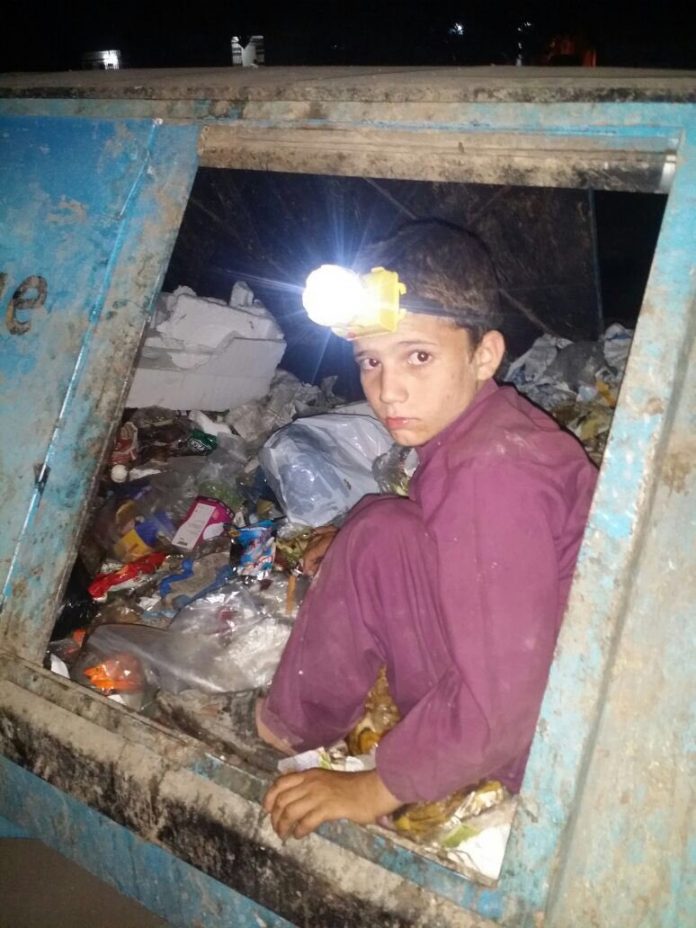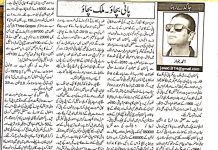While Children search garbage to feed them, our 3rd time democratically elected PM returns in the state sponsored PIA flight with his family. By Ahmad Jawad
When the sun sets and children go home to be with their parents, an eight-year-old child fastens a battery on his head and jumps into a stinking garbage dump in Saddar to find any valuables that people have discarded but still can earn him a few rupees.
The scene was so horrible. One cannot even imagine going close to the container filled with harmful waste. But for Tahirullah, 8, it is the matter of running his kitchen. Sometimes he is also accompanied by a friend, Abdul Wali, 9.
“I collect plastic bottles, tins, papers, boards, metals and other discarded items, for which I get some money from the scrap dealers. This is what I need to run our kitchen,” the little skinny kid from Miskeenabad near Nauthia locality told The News. He was filling a sack from a dump on Bara Road to sell it to a scrap dealer.
The kid first told this scribe that he was a student of grade-2 in a local school. Later, Tahir and Abdul Wali both said they only learn the Holy Quran in the local mosque as they cannot afford going to school.
Thousands of people live in Bungalows, flats and small houses in the vicinity. However, hardly anyone notices the way Tahir and his friend are trying to support their families by risking their lives and spending time in a virulent environment.
“I was shocked to see the kid jumping into a garbage container late night. He was alone and had fastened a battery on his head like coalminers to find something valuable from the dump,” Humayun Khan, technical manager at a local television channel, told The News.
He added that these kids needed to be in schools to make a better future.
There are many scavenger kids who carry a magnet fastened with a rope to put it in dirty drains to find something valuable. The water they work in carries viruses and can cause infectious diseases.
“At the end of the day, I collect things that are sold against a few hundred rupees. This is how I run our kitchen,” said a young kid from Kohat Road.
“There are thousands of such kids in Peshawar. I don’t know why their parents let them do the harmful job. The government must do something practical for their welfare,” said Humayun.
Many of these kids are prone to be used for terrorist and criminal activities against a meagre amount. These kids can be easily brainwashed.
According to some estimates, there are 1.2 to 1.5 million street children in Pakistan, most of them doing odd jobs and working in extremely harmful environment.
The annual “State of Pakistan’s Children Report” by Society for the Protection of the Rights of the Child (SPARC) has reported while quoting national and international sources that there are 25 million out of school children in Pakistan.
The federal and provincial governments had taken some steps for the welfare of the street children in the past few years. However, the arrangements can help hardly a few per cent of these kids.
“The Khyber Pakhtunkhwa government has launched a flagship project for street children, Zamung Kor, on Charsadda Road. This is an initiative of Pakistan Tehreek-e-Insaf Chairman Imran Khan and Khyber Pakhtunkhwa government,” said Meraj Humayun Khan, a member of the Khyber Pakhtunkhwa Assembly who has served in development and education sectors for decades.
Pakistan Tehreek-e-Insaf Chairman Imran Khan and Chief Minister Pervez Khattak inaugurated the project in November last year.
According to Meraj Humayun, the dream is to take street children into a Centre of Excellence where they will be nurtured and educated so they become leaders and entrepreneurs. “The first institution, which can accommodate 1000 children is already functioning in Nasapa Flats,” she said.
Apart from the locals, there are hundreds of thousands of Afghan refugee kids who are doing harmful odd jobs to feed their families instead of going to schools. There are an estimated 1.5 million refugees in the country while around one million of Afghans are those who are not registered.
“When families are forced to flee their homes, children are severely impacted. Torn from school, children are often deprived of education and exposed to exploitation and abuse,” Duniya Aslam Khan, spokesman for the United Nation High Commissioner for Refugees.
According to the UNHCR spokesperson, the UN refugee agency believes all refugee children should be in school and it was working to get them access to education so they can build a better future for themselves and their communities.
“In Pakistan, about 80 percent of the school-age Afghan refugee population is currently out of school, resulting in extremely low literacy among Afghan refugees. Only an estimated 33 percent of Afghan refugees in Pakistan are able to read and write. Literacy among women and girl refugees is even lower, at approximately 7.6 per cent,” added Duniya Aslam Khan.
According to the International Labour Organisation, there are over 12 million child labourers in Pakistan, with an additional 264,000 kids as domestic child labourers. The state of the child labourers is deteriorating with the passage of time for having no proper attention from the government.







